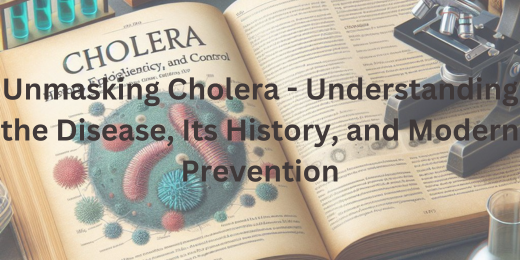Cholera prevention
Cholera, a bacterial infection caused by Vibrio cholerae, is a serious health concern worldwide. Cholera symptoms often include severe diarrhea, vomiting, and dehydration, making it a potentially life-threatening disease. However, through effective cholera prevention measures, this disease can be controlled.
Historically, cholera has been responsible for devastating outbreaks, but with advancements in medical science and improved sanitation, its impact has lessened. Cholera prevention primarily involves maintaining clean water sources and promoting proper hygiene practices. Simple actions like handwashing with soap and drinking clean, treated water can significantly reduce the risk of infection.
Understanding the basics of cholera, its symptoms, and the importance of cholera prevention is crucial for individuals and communities. By following these practices, we can protect ourselves and our communities from this infectious disease, just as being aware of tetanus symptoms such as muscle stiffness, jaw cramping, and difficulty swallowing emphasizes the importance of prompt treatment to prevent potential complications and ensure overall health.
Historical Perspective on Cholera
Taking a look back in history, cholera has been a significant health challenge. The disease has been around for centuries and has caused many outbreaks, leading to widespread illness and, unfortunately, death. Understanding the historical perspective on cholera helps us appreciate the progress made in combating it.
In the past, people didn’t have the knowledge or resources we have today for cholera prevention. This led to cholera spreading quickly through contaminated water and poor sanitation. The lack of effective treatments made it a terrifying threat.
However, over time, our understanding of the disease has grown, and we’ve developed methods to prevent cholera. Improved hygiene, access to clean water, and vaccines have made a significant difference in reducing its impact.
In summary, the historical perspective on cholera reminds us of the challenges faced in the past and highlights the importance of ongoing efforts in cholera prevention to protect public health, while tuberculosis, often termed a silent killer, stealthily attacks the lungs and, if left untreated, can have severe consequences, making awareness and early detection crucial for effective intervention.
Cholera’s Pathophysiology and Symptoms
Understanding cholera symptoms and its pathophysiology, or how it affects the body, is crucial for effective management. Cholera is caused by the Vibrio cholerae bacterium and mainly spreads through contaminated water and food. Once inside the body, these bacteria produce toxins that lead to profuse, watery diarrhea and vomiting. This rapid loss of fluids can result in severe dehydration and electrolyte imbalances, which can be life-threatening if not treated promptly.
Key cholera symptoms include diarrhea, which can be so intense that it resembles “rice water,” along with vomiting and muscle cramps. Without swift medical attention, a person can deteriorate rapidly. Oral rehydration therapy, which involves drinking a solution of water and salts, is the primary method to combat dehydration caused by cholera.
In summary, knowing the pathophysiology of cholera and recognizing its symptoms are vital for early detection and proper treatment, ultimately saving lives through effective cholera prevention. Similarly, the effects of mumps can include painful swelling of the salivary glands, fever, and potential complications such as orchitis or meningitis, underscoring the importance of vaccination for prevention.
Modern Approaches to Cholera Prevention
In today’s world, there are effective cholera prevention methods that help keep this disease at bay. One of the key approaches is improving hygiene. Teaching people to wash their hands with soap and clean water can go a long way in preventing cholera. Avoiding contaminated water sources and consuming safe, treated water is equally important.
Vaccination is another modern tool in cholera prevention. Vaccines can provide immunity against cholera for a certain period, offering protection to individuals and communities. Additionally, better sanitation practices, like proper waste disposal and sewage management, play a vital role in preventing the spread of cholera.
Overall, combining these modern approaches to cholera prevention can significantly reduce the risk of outbreaks and protect public health, making it possible to control this disease better in today’s world. Similarly, recognizing the impacts of sleep apnea, which disrupts sleep, causes daytime fatigue, and poses potential long-term cardiovascular risks, emphasizes the need for comprehensive health management in contemporary public health strategies.
Hygiene and Sanitation Measures
When it comes to cholera prevention, hygiene and sanitation measures are crucial. Hygiene means keeping ourselves and our surroundings clean. This includes washing our hands with soap and clean water, especially before eating and after using the toilet. Doing this can help prevent the spread of cholera.
Sanitation is about safely disposing of waste and managing sewage. In areas with poor sanitation, cholera can spread easily through contaminated water sources. Proper waste disposal and sewage systems can stop this from happening.
Access to clean, treated water is also vital. Drinking water from a safe source and storing it properly can reduce the risk of cholera. In some cases, vaccines can offer protection.
By following these hygiene and sanitation measures, we can significantly reduce the chances of getting cholera and help keep ourselves and our communities healthy.
Conclusion and Future Prospects for Cholera Control
In conclusion, understanding cholera symptoms and embracing effective cholera prevention strategies is vital to safeguard public health. Over the years, we’ve made significant progress in controlling this disease, thanks to improved hygiene practices, clean water access, and vaccination programs. However, cholera remains a threat in some regions, particularly in areas with inadequate sanitation.
The future holds promise as researchers continue to work on advanced vaccines and treatments. These innovations can potentially enhance our ability to combat cholera even further. To achieve lasting control, a global effort to improve sanitation and promote hygiene education is essential.
In the years to come, our focus should be on building resilient healthcare systems and infrastructure to prevent cholera outbreaks. By combining modern science with ongoing commitment to hygiene and sanitation, we can aspire to a world where cholera’s impact is minimal, safeguarding the well-being of communities worldwide.



